





|
Other Tractors from the Quad Cities |
|
Although not clones or affiliates, I am including some of the more obscure tractors built in and around what is now the Quad Cities area in the teens and twenties. Unlike the major companies of John Deere, Farmall, Rock Island Plow Company and the Moline Plow Company; these tractors never were major players and disappeared almost as fast as they appeared. |
|
Below: The Velie |

|
Copy write 2011, 2012, 2013 not for republication or sale without express written consent. All images are the property of their respective owners and are not to be reused without their express permission. |
J.G. Bolte 20-40 |
Golden West Tractor |
|
The Bolte Tractor was built in Davenport IA sometime around 1919. After a few ads in 1919 and early 1920, the Bolte disappeared as quickly as it appeared. Besides tractors, Joseph G. Bolte was a car dealer in Davenport, beyond that little is known. One detail that is known is that in 1920 Bolte was sued for failing to pay a loan, in addition to not making the payments, he had apparently sold the two cars that were his collateral. A cosigner had been required to secure the loan as by that time, Bolte had a poor reputation for credit. Despite its 20-40 rating, the Bolte only weighed about 5,000 pounds. Its most unique feature was its steering mechanism the company called “the Square Turn Design. A patent was filed in 1919 and granted in 1923, long after the tractor had disappeared. According to Dick Bockwoldt, his father recalled at least two being tested near the farm he grew up on, but it seems unlikely any were sold |
|
I stumbled across these photo’s in an online archive, but have so far found virtually nothing about this tractor. The Golden West was built by E.B. Parkhurst and the Muscatine Motor Company of Muscatine IA. According to A photo in Wendel’s “Standard Catalog of Farm Tractors”, only a brief mention is made in advertising in1910. The photo’s are apparently from the Muscatine Library and the originals can be found HERE.
|
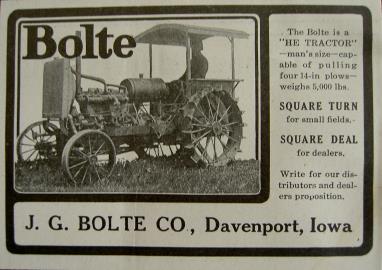
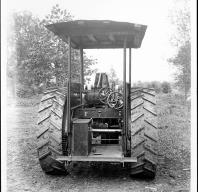
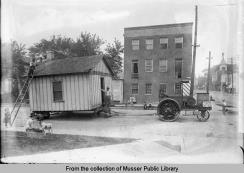
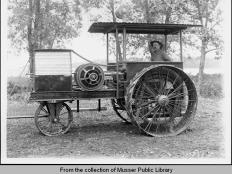
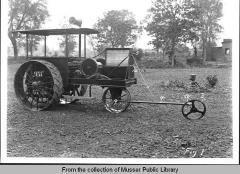
“Creeping Grip” Crawler 60-45 and 40-30 |
|
Another virtual unknown of the area was the circa 1913 Western Implement and Motor “Creeping Grip” crawler of Davenport Ia, an early halftrack design. Originally called the “Creeping Tiger”, it came in two sizes, a 60-45 and a 40-30 (the Creeping Grip was one of the rare companies to list belt power before drawbar power in its ratings). Although never a major name, the Creeping Grip would play an interesting role in the development of modern warfare. When Western Implement and Motor Company was bought out by Chicago’s Bullock Tractor Co in 1914, the Creeping Grip name remained and the smaller Baby Creeper was added. During the development of the tank, a Bullock Creeping Grip chassis was used on the British 1915 No. 1 Lincoln Machine, one of the first forerunners of the modern tank. The results were unsatisfactory and numerous changes were required for the second prototype. |
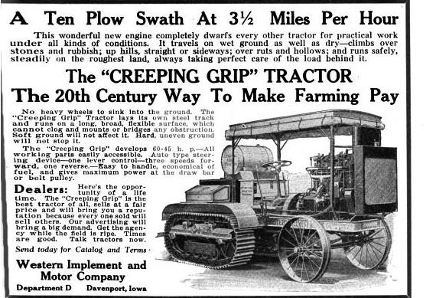
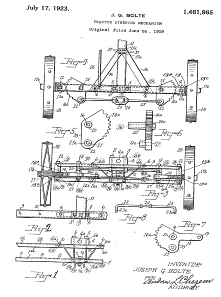
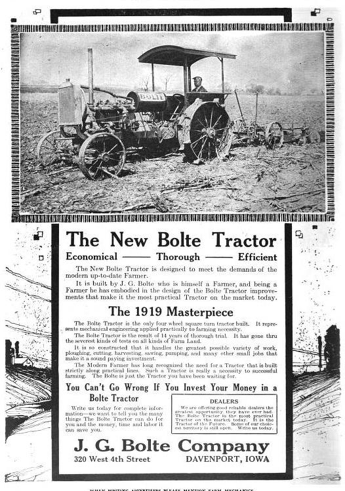
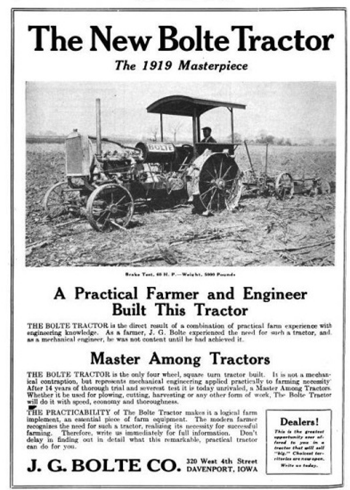
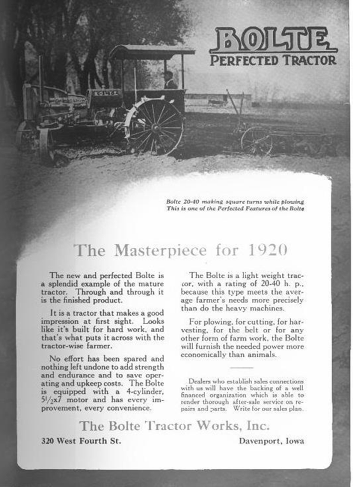
|
Cummings Traction Engine 1868 by Marcellus V Cummings in Geneseo IL |
|
from the 1874 Science record: “STEAM MOWING REAPING AND THRASHING MACHINE MR MARCELLUS V CUMMINGS of Geneseo Henry County Illinois has brought into successful use in that State a new invention for the purpose above mentioned which is illustrated in our engraving which is from a photograph of the machine. The boiler is thirty one inches in diameter by five feet in length and is of the tubular pattern. There are two steam cylinders each four by eight inches together with a water tank holding five barrels of water and coal bunkers containing five bushels of coal. The large driving wheels are five feet in diameter and eight inches in tread the front steering wheel operated as shown is four feet in diameter with similar tread. The grass sickle cuts six feet four inches and the grain sickle nine feet six inches. The inventor states that he drives his engine from farm to farm without the aid of horses and that it traverses over plowed land up hill or down with the greatest case The rate of speed is about four miles per hour and an acre of ground can be mown in twenty minutes. The grain thrashing machine is placed on a two wheeled carriage which is coupled on behind the engine and is thus hauled by the latter over country roads from place to place throughout whole counties. The entire weight of the apparatus is 4200 pounds.”
The Cummings mowing machine traction engine may have been the first successful self-propelled mowing machine and is regarded as one of the first farm traction engines to be built. It was rated at 8 hp and pulled an 1865 pattern Nichols & Shepard threshing machine with a 28 inch cylinder. |
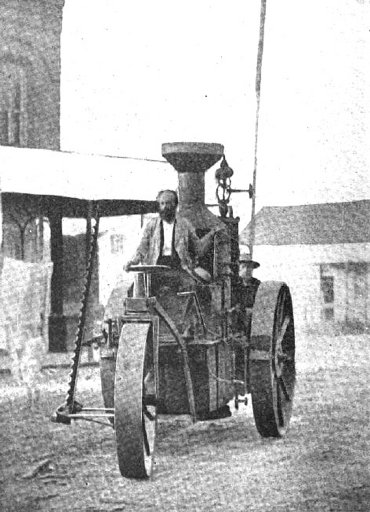
Charter “Sterling” Gas traction Engine |
|
In 1889 or 1890, the very successful Charter Engine Company of Sterling IL received a letter from a farmer named W.J. Jamieson of White Plains SD who had used a Charter engine on a home built chassis to build his own gas traction engine. The attempt was not a success as he had not figured out the gearing, but he felt the Charter Engine Company would be well served to build such a tractor, and he would place the first order himself. Sometime in 1890 or 1891, several prototypes were built and tested near Sterling IL and were then sent out to SD. L.F. Burger, son of the plant superintendent and who would also work for IH, was sent along with the tractors. Little is said about their success and failures, but at least some redesign work was required. George Hanson was charged with the task, and the new prototype worked so well it was decided to produce six for sale in 1895. Six sets of tractor wheels were ordered from the Rumely Company (who would later merge with Advance and built the legendary Oil Pull tractor) and included a steam engine stack and whistle so as to appear more steam like and when completed were immediately sent to South Dakota with Mr Hansen. The trials proved a disaster as the Sterling traction engine could barely pull itself, let alone the separator with it over rough ground, and when it did thresh, Hansen, in an attempt to show off, overloaded the separator and bogged it down. All six tractors came back to Sterling. Charter would continue to work on the design for a few years, but never became a major player in the tractor business. |
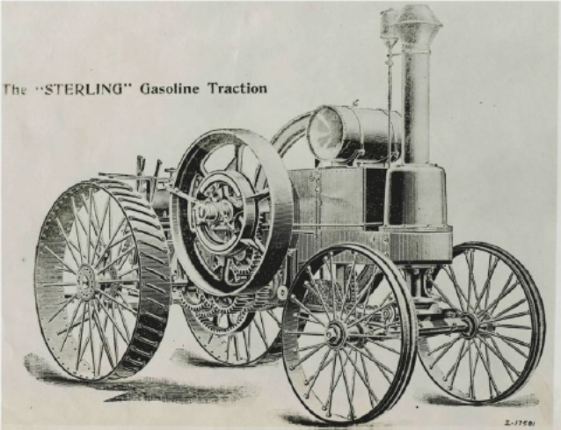
|
< Return to List |